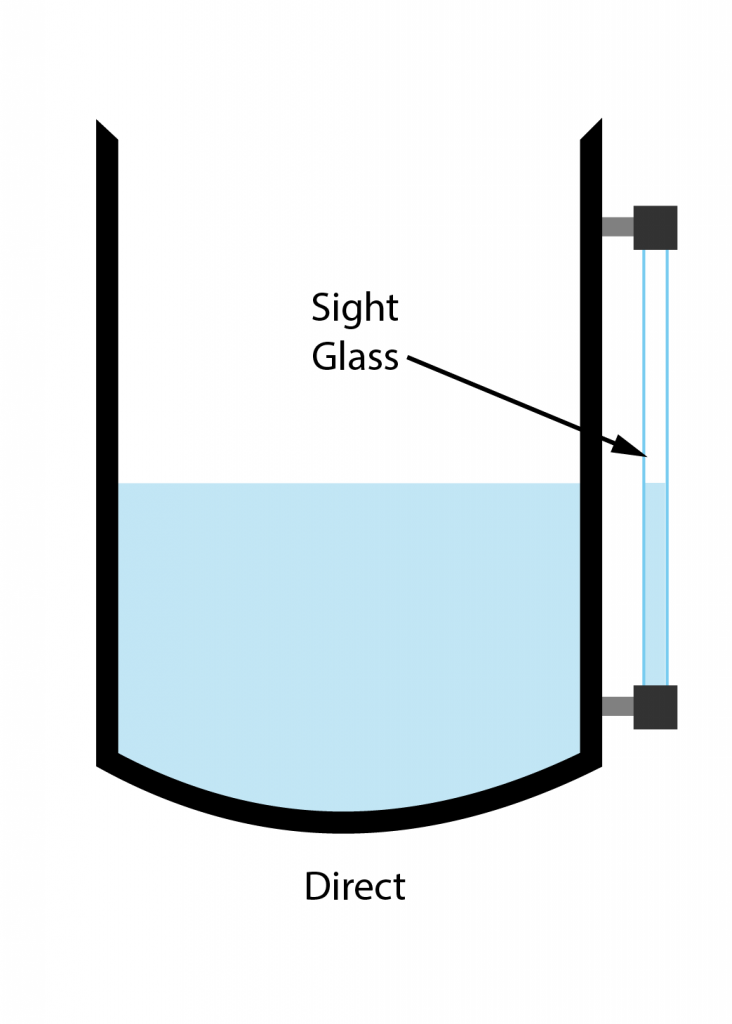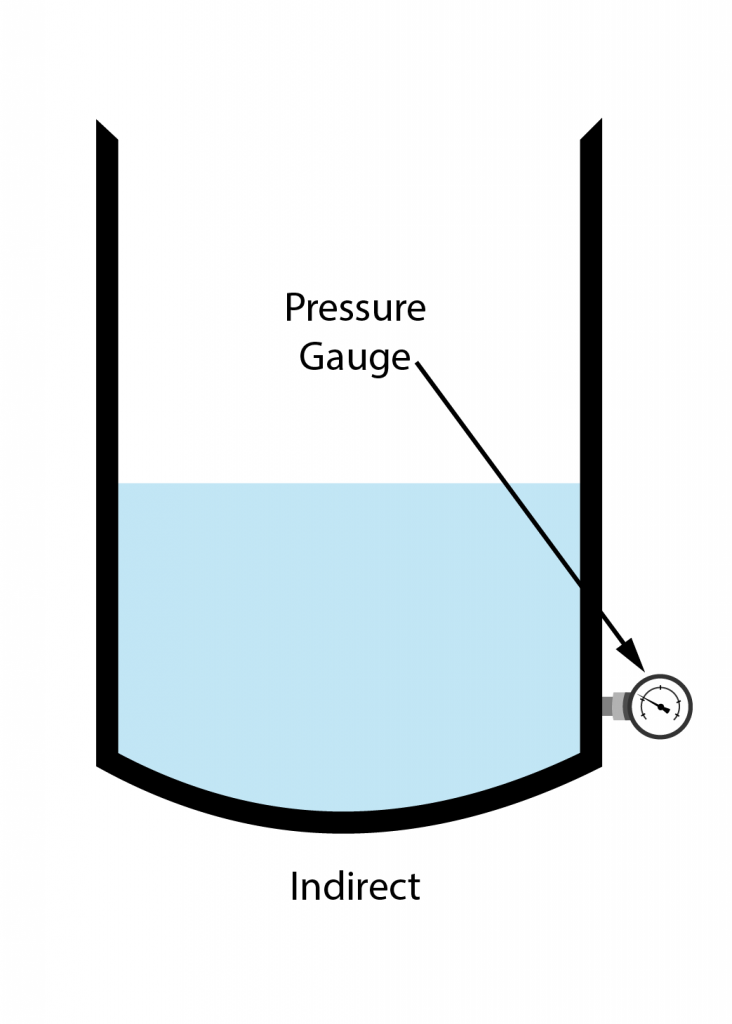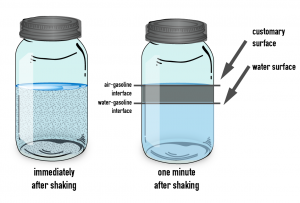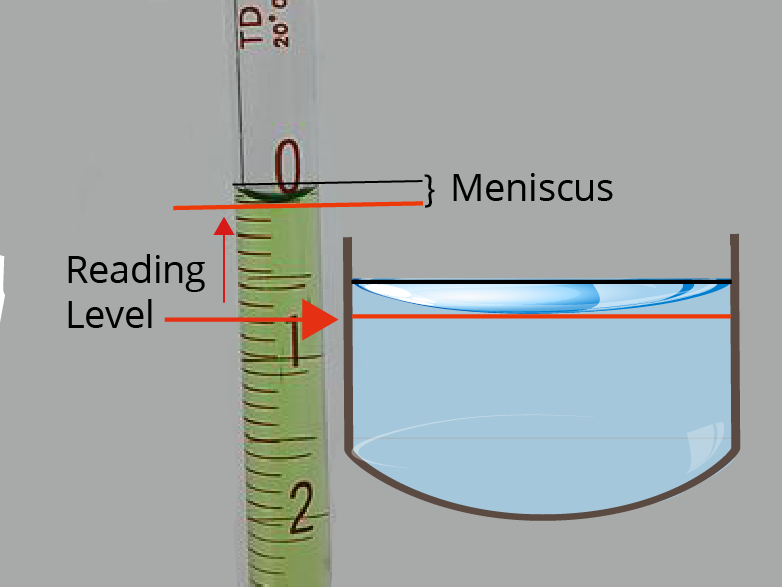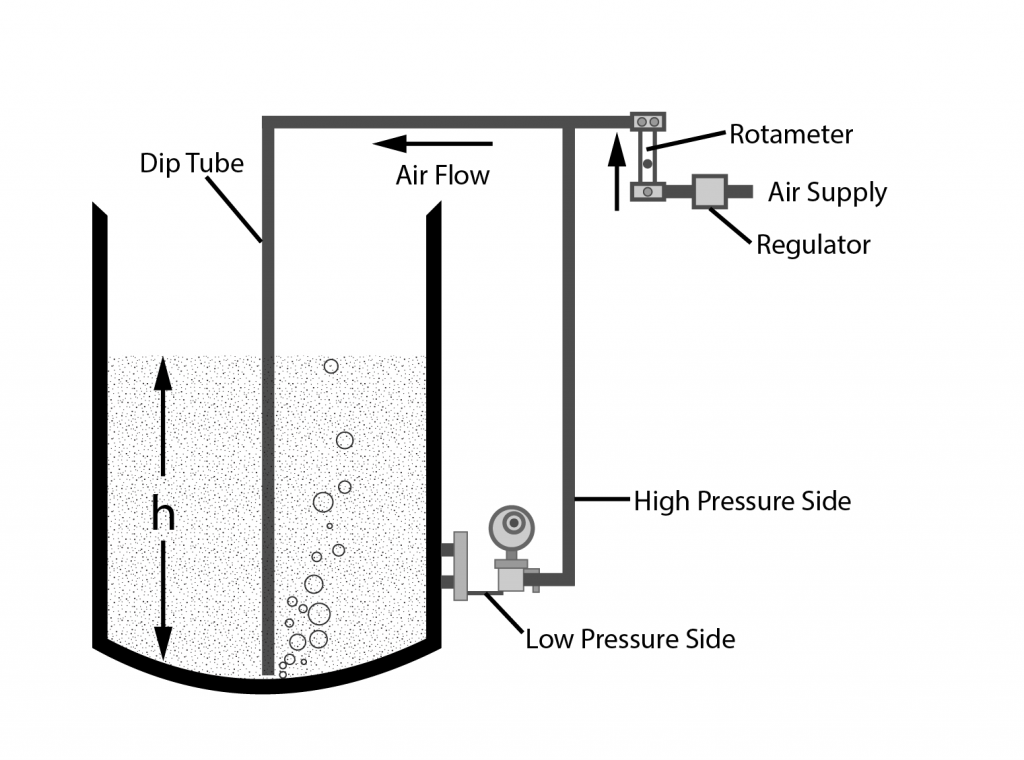Contents
Objectives
- Define ‘level’ and related terms
- Describe common types of Level instrumentation
- Demonstrate level measurements — bubbler, sight glass
- Perform level calculations and conversions
- Review Level instrumentation symbols on PID’s
- Perform pressure, temperature, level calculations – review
Reading
Terms to Know
- Innage
- Outage/ullage
- Direct level measurement
- Indirect level measurement
- Interface
- Meniscus
- Hydrostatic Head Pressure
- Level instruments, per presentation
Innage/Ullage
Question: Why might you use one or the other?
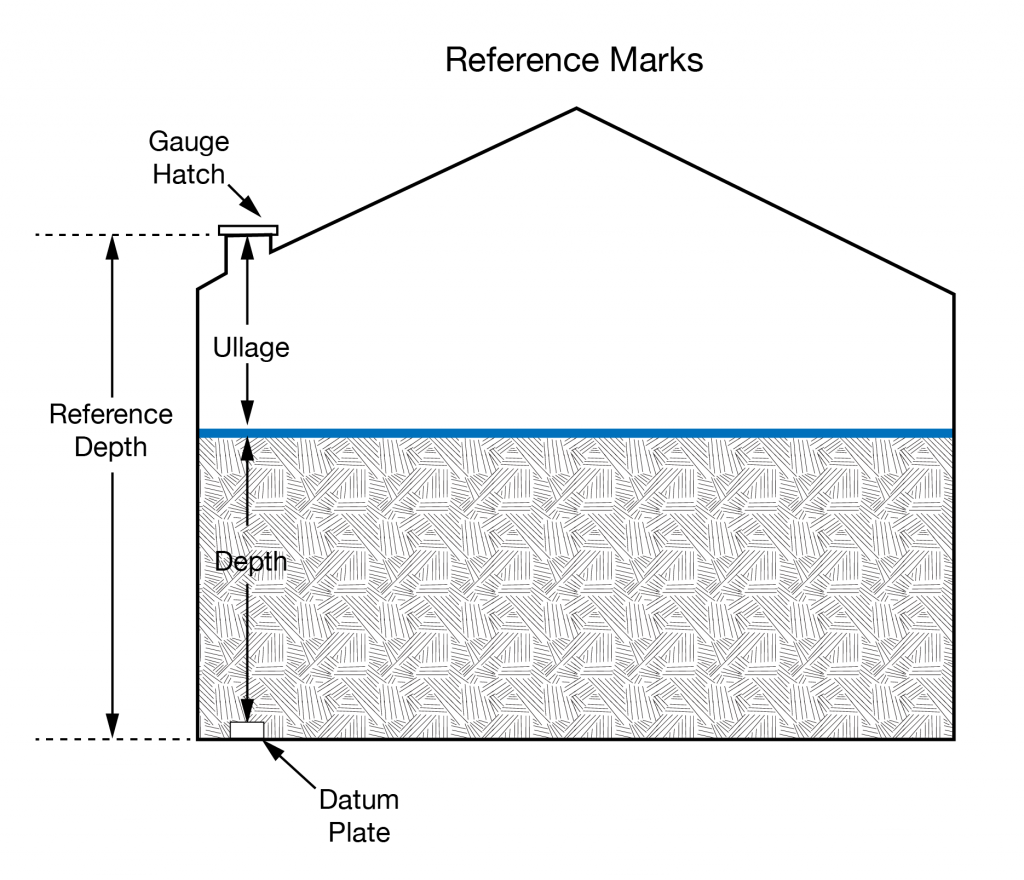
[image 140-4-01]
Direct/Indirect Level Measurement
Direct/Indirect Examples
Direct Level Instruments
- Sight glass
- Float
- Dipstick
- Tape gauge
Indirect Level Instruments
- Bubbler
- dP cells
- Displacer
Interface / Meniscus
Level — Hydrostatic Head Pressure
Pressure exerted by the depth of the liquid column (we’ve looked at this before…)
P = (hydrostatic head pressure) = in. H2O
h = height of the liquid column (liquid level) = in.
SG = specific gravity of the liquid (water SG = 1)
P = (1 in wc) x (h in. ) x (SG)
in.
Or P = h x SG (if everything is in the right units)
UNITS of Level vs. Pressure
Units of level = a length, height measurement: ft, in, mm, etc.
Units of hydrostatic head pressure = length, height of a particular fluid:
- in. H2O, mm Hg, in. w.c.,
- Sometimes in ‘feet of head’, implying water (this is used for pump data, ref. PRT 130)
Example 1
An open tank contains a liquid with a specific gravity of 1.735. If the level of the liquid is 123 in., how much head pressure, in in. H2O, will it exert?
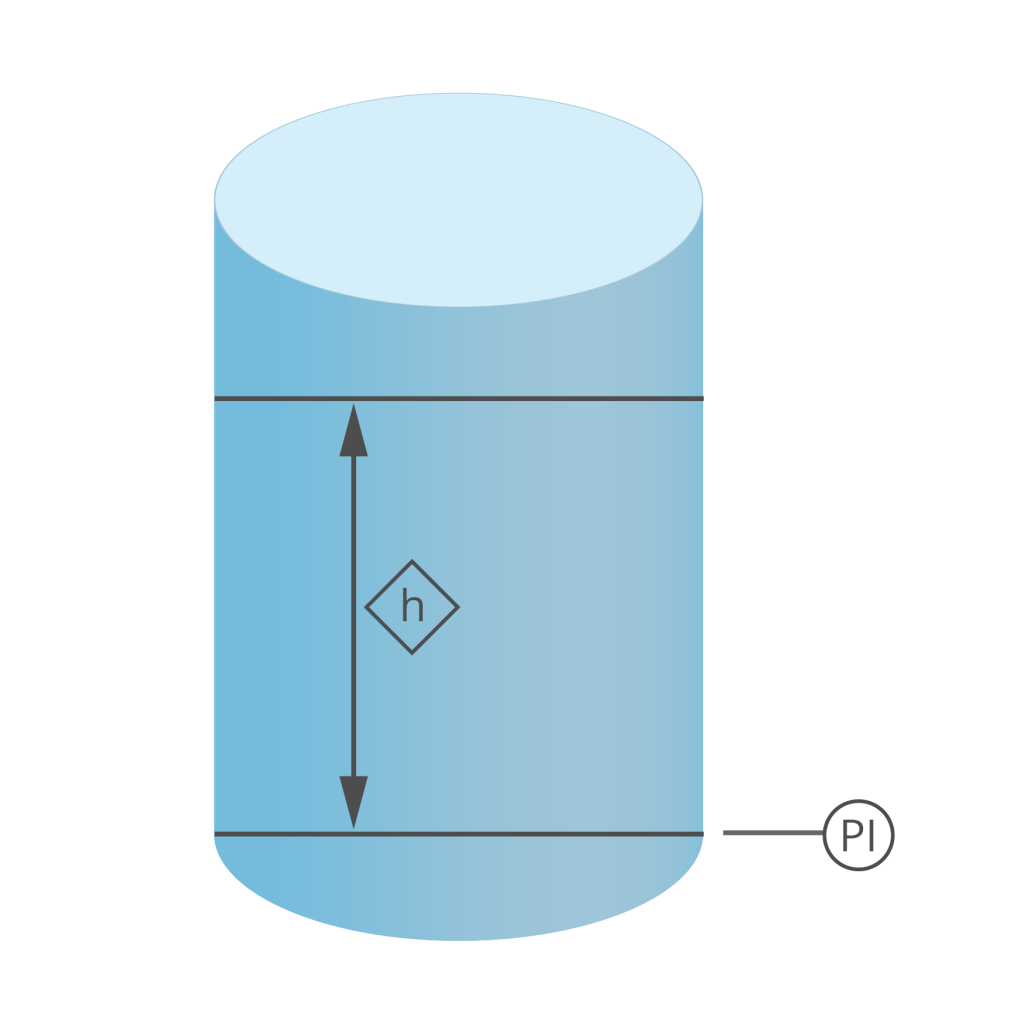
[image 140-4-07]
Equation to use:
- P = (1 in. H2O)(h)(SG) or P = h x SG
in. - SG = 1.735
- h = 123 in.
- P = (1 in. H2O)(123 in.)(1.735)
in. - P = 213.4 in. H2O
Level
If you know the hydrostatic head pressure and the SG, you can calculate level:
- P = h x SG, so
- h = P/SG
- h is in.
- P is in. H2O
IMPORTANT: Data must be in the right units for this simple equation to work. Always verify units before using equations.
Example 2
An open top tank is filled with a liquid that has a specific gravity of 0.873. The liquid exerts a head pressure of 193 in. H2O. What is the liquid level in inches?

[image 140-4-07]
- P = (1 in. H2O)(h)(SG) /in.
- P = 193 in. H2O
- SG = 0.873
- 193 in. H2O = (1 in. H2O)(h)(0.873)/in.
- h = (193 in.) / 0.873
- h = 221.1 in.
Be very careful with units — this is not water, so giving a level height as in. H2O makes no sense at all!
Level Instruments to Know
- Sight Glasses
- Float
- Tape Gauge
- dP cell
- Bubbler
- Displacer
- Ultrasonic, Radar, Nuclear
- Load Cells
Direct Measuring Instruments
- Sight Glass — see examples
- Float
- Gauge Tape
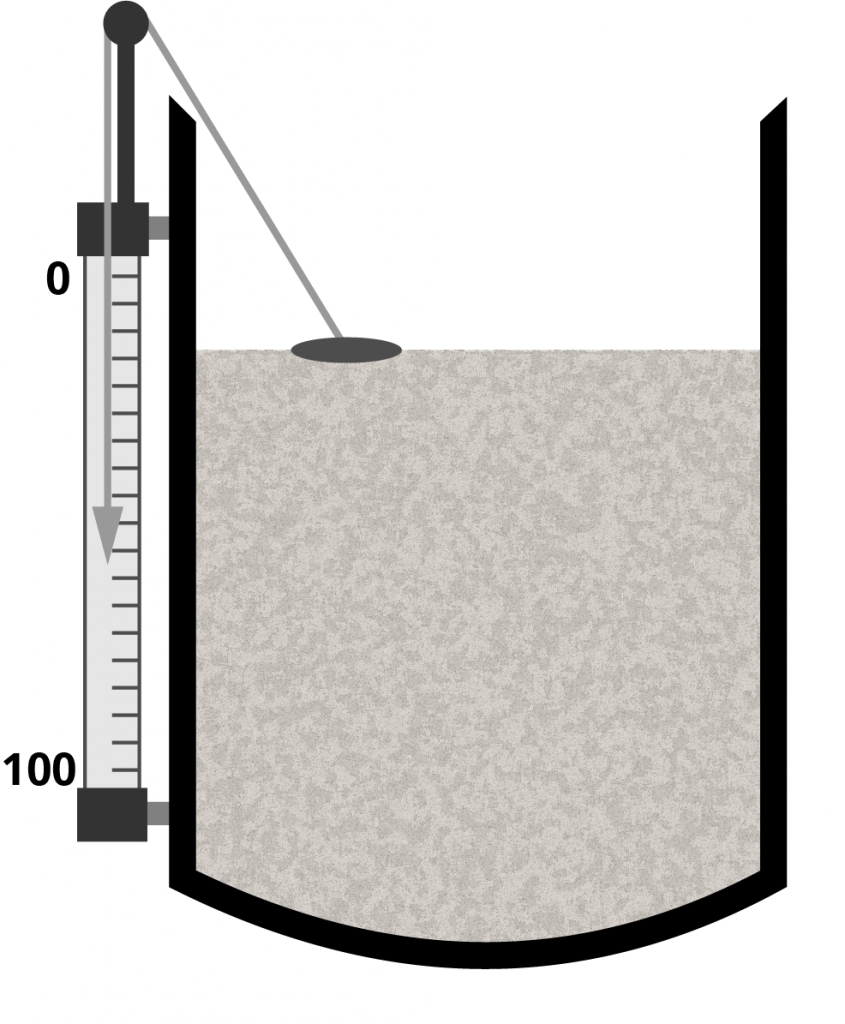
[image 140-4-06]
dP vs. PI
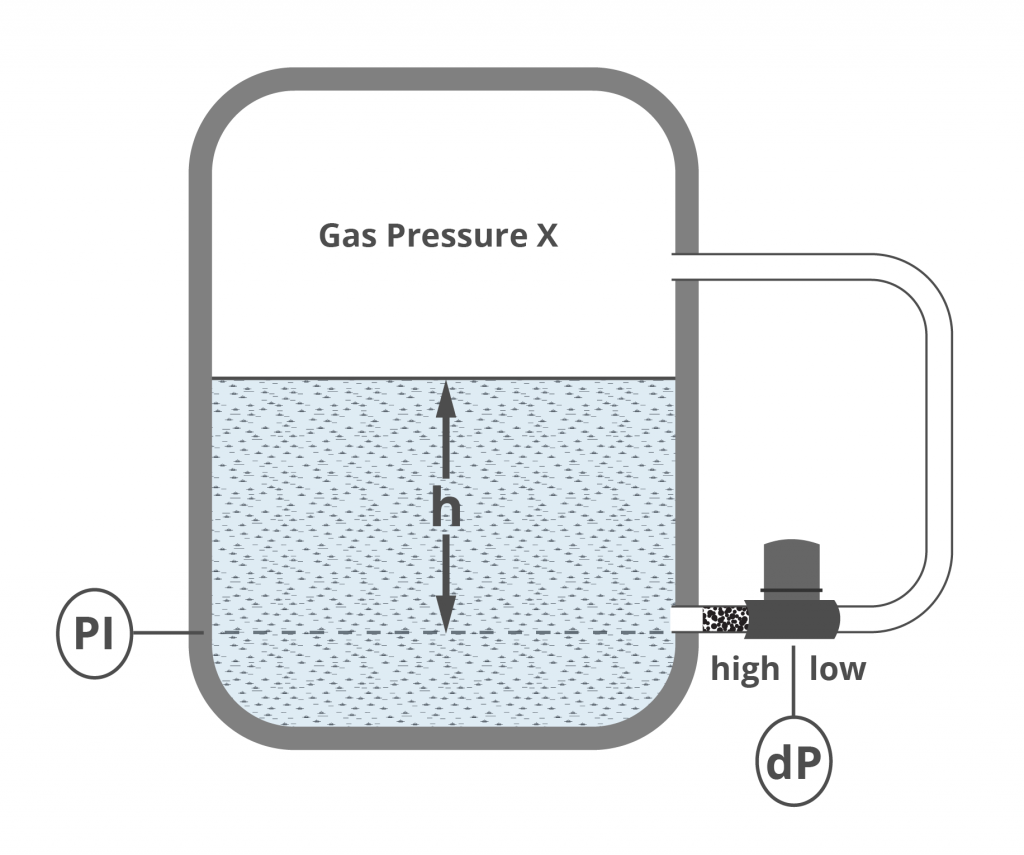
[image 140-5-06]
PI Measures All Pressures
- PI measures PX (vessel P) + PH (hydrostatic)
- P = PX + PH
- PX = 5 psi
- PH= h x SG = 67 in. x 1 = 67 in. H2O
- 67 in. H2O = 2.42 psi — (how do we know this?)
- P = 5 psi + 2.42 psi
- P = 7.42 psi at the PI
dP Cell – Measures Level Regardless of Vessel Pressure
- Low side of dP measures PX, vessel pressure
- High side of dP measures PX + PH (hydrostatic)
- Since it’s a differential, the final reading is
- dP = (PX + PH) — PX
- dP = PH
- PH = h x SG
- PH= h x SG = 67 in. x 1 = 67 in. H2O
- 67 in. H2O = 2.42 psi
- dP = 2.42 psi
Advantage of dP Cell?
- dP cell measures only the hydrostatic head from the liquid level — the vessel/system pressures are canceled out.
- To use a single PI, you have to KNOW the vessel pressure and include that in any calculations.
- Consider how the reading on the PI will change with vessel pressure — how do you know the level is changing or not?
Example Question
What is the water height in inches, h, if the pressure on the bubbler reads:
- 1.5 psi
- 13 psi
- 72 psi
0.433 psi = 1 ft water (WHERE DOES THIS COME FROM?)
0.433 psi = 12 in. water (because 1 ft = 12 in.)
1 psi = 12 in. water/0.433
1 psi = 27.7 in. water
Bubbler P = h x SG, so P/SG = h
FIRST — convert all pressures to in. water
- P = 1.5 psi = 41.6 in. H2O
- P = 13 psi = 360.1 in. H2O
- P = 72 psi = 1994.4 in. H2O
- h = P/SG (SG =1.3)
- h = 41.6/1.3 = 32 in.
- h = 360.1 / 1.3 = 277 in.
- h = 1994.4 / 1.3 = 1534.15 in.
(NOTE that the level units are different from P units)
How to Recognize Level Instruments in the Field
Many dP and P instruments are used to indirectly measure level. How do you identify them in the field?
- Look at how they are connected/configured in the process.
- Single PT — would have to be at the bottom of a liquid column, right? (not too commonly used this way)
- dP is very common
- First — make sure it’s a dP transmitter — H/L connections, possibly two visible leads to process
- One at bottom of a liquid column, one to atmosphere
- One at bottom of a vessel, one in the vapor space of a vessel
- Two connections to a liquid-full container, at a specific height differential
- One to a bubbler line, one to atmosphere
- Probably many more
The bottom line is — look at how it’s configured, think what information you get from that data
Displacers
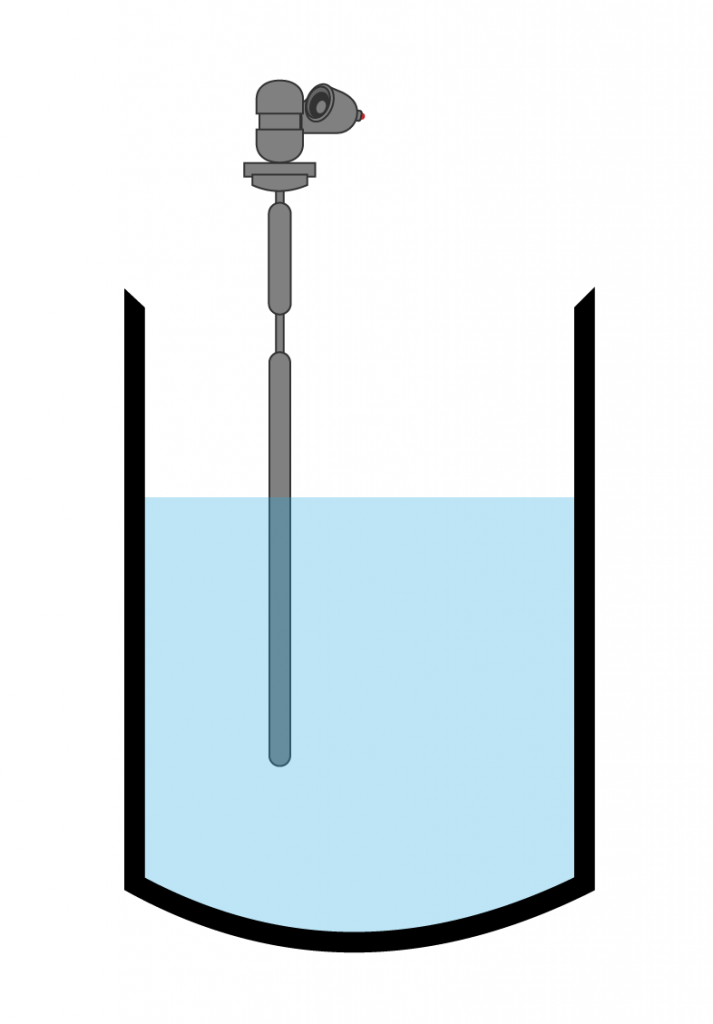
[image 14-4-09]
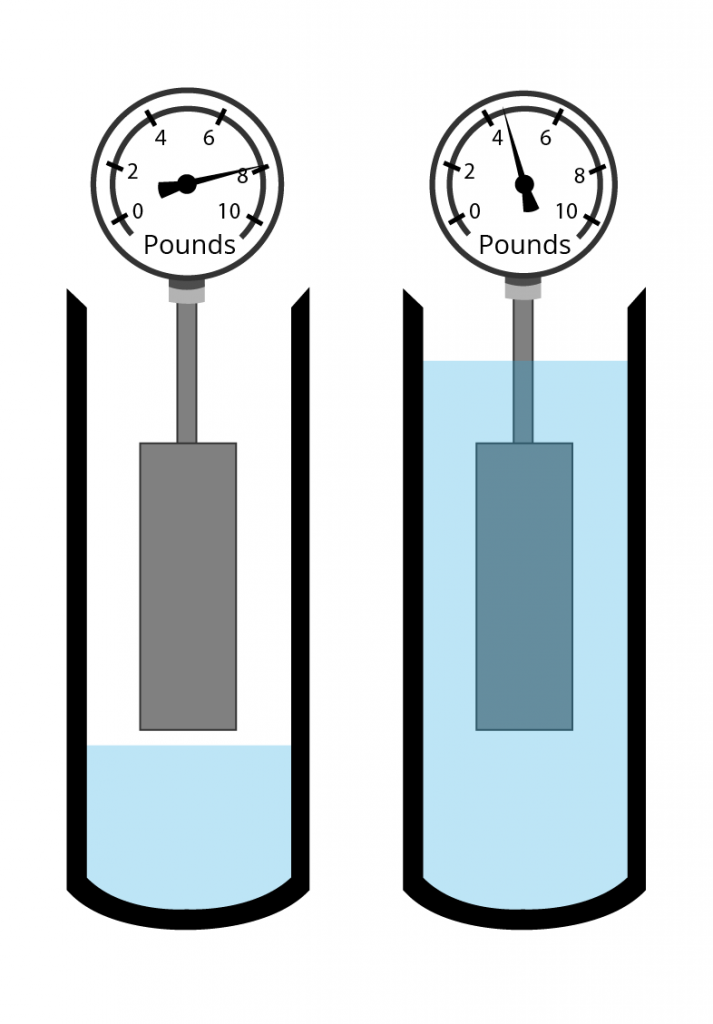
[image 140-4-10]
Other
Ultrasonic/Radar: Measure ullage distance, infers level. Used when physical sensors may not work (i.e. asphalt tankage)
Nuclear: uses gamma radiation to detect matter inside the vessel. Used for difficult measuring situations, extreme conditions
Load Cells: Weigh the contents, can calculate level
- What other info do you need to make this calculation?
Level – PID Symbols
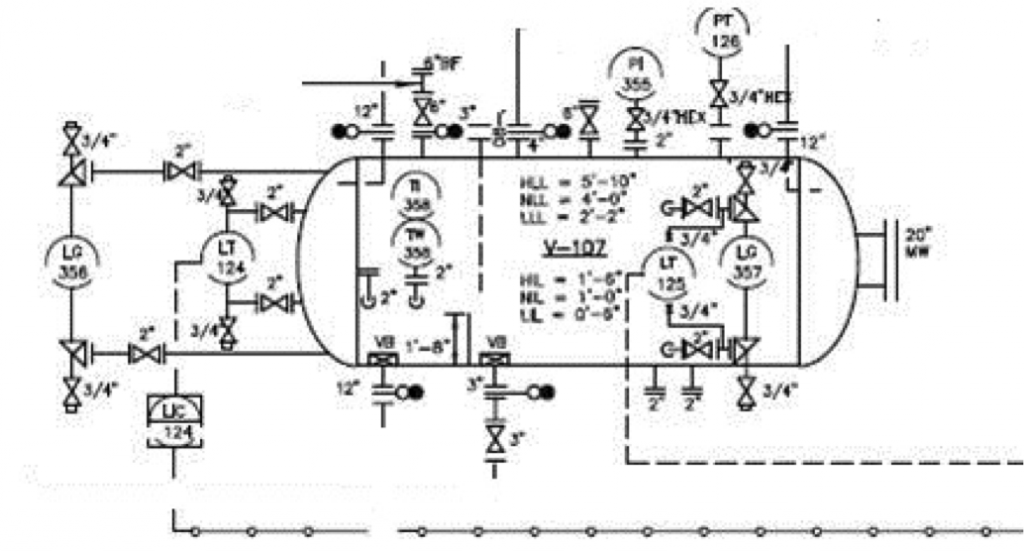
[image 140-4-11]
Review
In a closed container,
P1V1/T1 = P2V2/T2
Pressure and Temperature must be in ABSOLUTE UNITS —
- P = psia
- T = K or R
Volume units just have to be consistent
Step 1 = get all units and variables identified
450 psig, 125 C, 437 ft3 = 235 psig, 564ft3, ???C
| Variables | Data, units | |
| P1 | 450 psig | |
| T1 | 125 C | |
| V1 | 437 ft3 | |
| P2 | 235 psig | |
| T2 | ? | |
| V2 | 564 ft3 |
Step 2 = get all units correct (absolute T, P)
| Variables | Data, units | Data, in absolute units |
| P1 | 450 psig | 464.7 psia |
| T1 | 125 C | 398 K |
| V1 | 437 ft3 | 437 ft3 |
| P2 | 235 psig | 249.7 psia |
| T2 | ? | ? |
| V2 | 564 ft3 | 564 ft3 |
Step 3, set up and solve equations
(464.7 psia x 437 ft3) / 398 K = (249.7 psia x 564 ft3) / T2
T2 = (249.7 psia x 564 ft3 x 398 K) / (464.7 psia x 437 ft3)
T2 = 276 K
T2 = 3 C (answer should be in same units as original data, unless specified otherwise)
Scaling Calculations
Level instrument operating range is
5 ft — 85 ft. What is the 4-20 mA reading at different levels?
VALUEB = {[(VALUEA — LRVA)/SPANA] x SPANB} + LRVB
Level: LRV = 5 ft URV = 85 ft Span = 80 ft
Signal: LRV = 4 mA URV = 20 mA Span = 16 mA
So:
?? mA = {[(Level Reading — 5 ft)/80 ft] x 16 mA} + 4 mA
